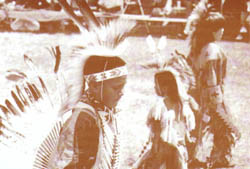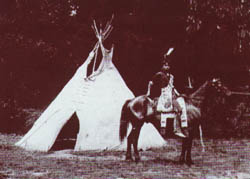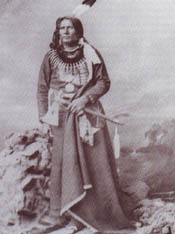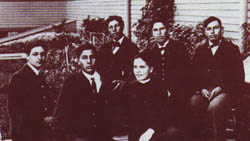
Ho-Chunk Historical Society Photo
HO-CHUNK
The Ho-Chunk people, also known as the Winnebago, call themselves “Ho-Chungra;” this word means “people of the Parent Speech.” The Ho-Chunk were part of a group of Siouan people living in Northwest Kentucky from about 500 BC to 200 AD, when they began a migration toward Iowa and Wisconsin. They first made contact with Europeans—the French—in 1614 when a group of Ho-Chunk hunters encountered Samuel de Champlain along the western banks of Lake Huron. After recovering from several outbreaks of smallpox after the French returned in 1634, the Ho-Chunk joined the French against the Iroquois League in the Beaver Wars of 1682-1697. They again backed the French in the French and Indian War of 1755-1763. Subsequently, they joined the Ottawa Chief Pontiac’s efforts to end British involvement in the Great Lakes area, but when this effort failed, the Ho-Chunk fought with the British against the Americans in the Revolutionary War. They also joined the British in the War of 1812. Soon after, the Ho-Chunk signed their first treaty with the United States in 1816.
This treaty began a long line of cessation treaties, which over the course of eleven years (1829 to 1840) led them to relinquish all their land in Illinois and Wisconsin. The Ho-Chunk then spent time on reservations in Northeast Iowa, Central Minnesota, South Central Minnesota, and South Dakota. After seven hundred people died of starvation at the South Dakota reservation, the Ho-Chunk moved to Northeast Nebraska and bought land from the Omaha that was to become known as the Winnebago Indian Reservation. The Ho-Chunks were forced to give up three-fourths of their reservation in 1887, and the tribe’s legal standing was almost terminated in the 1950’s. However, the Ho-Chunks of Nebraska survived these hardships, and today there are approximately 3800 Ho-Chunks on the Tribal rolls; about 1200 of them live on the Winnebago Reservation. The Nebraska Ho-Chunks opened the Winn-A-Vegas Casino in 1992 and have used its proceeds to invest in hotels, their Tribal College, and reservation infrastructure.
Source: “Ho-Chunk of Nebraska,” pamphlet prepared by David Lee Smith for the Ho-Chunk Historical Society (Rt. 1, Box 21; Winnebago, NE 68071).

Henry F. Turner on horseback, beside an Omaha teepee.
Courtesy Nebraska State Historical Society
OMAHA
The Omaha—“those going against the wind or current”—migrated from near the Ohio and Wabash Rivers to the mouth of the Missouri River. After Sioux attacks and the separation of the Ponca nation, previously a part of the Omaha band, into a separate tribe, the Omaha settled near Bow Creek, Nebraska. The Omaha tended to relocate their villages every eight to fifteen years as made necessary by disease or Sioux encroachment. They adopted the tipi and earthen lodge shelters of their Sioux and Pawnee neighbors, eventually discarding the bark huts used in the Ohio River area. Omaha women tended to the villages and agriculture, while the men hunted buffalo.
The Omaha signed their first treaty with the United States in 1815, in which they acknowledged both the “peaceful relations” between the U.S. and the tribe and the “protecting power” of the U.S. government. This treaty marks the formal entrance of the government into tribal affairs. Subsequent treaties were made which allowed the U.S. to use discretionary force to protect trappers and traders, and which ceded all Omaha claims to land in Iowa. In 1854, the Omaha were among the nine tribes summoned to Washington, D.C., to conclude land treaties. The Omaha ceded all their land except for 300,000 acres along the Missouri River. In 1865, the Omaha sold a part of that land for the establishment of the Winnebago Reservation.
The Omaha culture was greatly affected by contact with white traders and settlers; much of the religious significance related to traditional hunting and agriculture was lost through this process. The Omaha attempted to adopt white cultural and economic values in order to peacefully remain on their lands, but neither their Sioux neighbors nor the white settlers appreciated their efforts. The Omaha, caught between these two superior forces, “endured with heroic patience.”
Source: “Indians of Nebraska: Omaha,” pamphlet prepared by the Nebraska Indian Commission (P.O. Box 94981; Lincoln, NE 68509-4981).

Chief Standing Bear "Machunahzhin"
The first great leader of Indian rights.
Courtesy Nebraska State Historical Society
PONCA
The Ponca, once a part of the Omaha band, lived on the west bank of the Missouri River at the time of Lewis and Clark’s exploration. In 1817, the Ponca signed their first treaty with the United States, which was followed by a 1825 treaty acknowledging the sovereignty of the U.S. government over Ponca lands and authorizing the government to regulate all trade and commerce. All Ponca claims to land, “expect for a small portion on which to colonize or domesticate them [the Ponca],” were nullified in the treaty of 1858. In 1865, the final treaty between the U.S. and the Ponca created a reservation of 96,000 acres in the present-day Nebraska counties of Knox and Boyd.
However, the Fort Laramie Treaty of 1868 annexed the Ponca reservation into the Great Sioux reservation, making the Ponca trespassers on their own land. The government wanted to relocate the Ponca to the Indian Territory in Oklahoma but promised the Ponca chiefs the right to return to Nebraska if they did not find suitable land in Oklahoma. When the chiefs rejected land in Indian Territory, government agents refused to take them back to Nebraska. The Ponca chiefs set out on their own, fighting off cold and starvation to return to the Niobrara valley, where they found their people preparing for the move to Oklahoma. Federal troops enforced removal orders, and the Ponca arrived in Indian Territory in 1878.
The Ponca, seriously weakened by the long march to Oklahoma, suffered devastating illness and longed for their home in the north. When Chief Standing Bear’s eldest son died, he and a few other Ponca decided to return to their home to bury this member of their tribe. Because Indians could not leave the reservation without permission, the army took them into custody and prepared to return the group to Oklahoma. The Omaha Daily Herald publicized the forced return of the Ponca, and two Omaha attorneys suggested that a writ of habeas corpus could prevent this action. The U.S. government, however, disputed the right of Standing Bear to obtain a writ of habeas corpus on the grounds that an Indian was not considered a person under the law.
Judge Elmer S. Dundy, ruling on the case of Standing Bear v. Crook in 1879, upheld Standing Bear’s right to a writ of habeas corpus; the Supreme Court subsequently dismissed the case on appeal. This allowed Standing Bear and the Ponca to return to Nebraska; however, at that time, they had no home there. In 1881, 26,236 acres in Knox County were returned to the Ponca.
In 1966, the U.S. Congress voted to terminate the legal existence of the Northern Ponca tribe, causing their land and other tribal holdings to be dissolved. In the 1970s, the Ponca met with several organizations, including the Indian Center of Lincoln, to begin their efforts for reinstatement. In 1988, the Nebraska Unicameral passed Legislative Resolution 128, extending state recognition to the Ponca; in 1990, the U.S. Senate unanimously passed the Ponca Restoration Act, which was signed into law by President George H.W. Bush.
Source: “Indians of Nebraska: Ponca,” pamphlet prepared by the Nebraska Indian Commission (P.O. Box 94981; Lincoln, NE 68509-4981).

Santee Normal Training School high school pupils.
Courtesy Nebraska State Historical Society
SANTEE SIOUX
“The whites were always trying to make the Indians give up
their land and live like white men—go to farming, work hard
and do as they did and if the Indians and tried to make the whites
live like them, the whites would have resisted, and it was the
same way with many Indians.”
--Big Eagle-“Wamditanka”
The Santee Sioux originally inhabited north-central Minnesota, where they lived a relatively settled life far different from their nomadic western Sioux counterparts. After their defeat by the Chippewas at the Battle of Kathio in the late 1700s, they were forced to move to the southern portion of Minnesota. This brought them in closer contact with white settlers and set the stage for future conflict and hardship.
The Santee signed their first treaty with the United States in 1805, in which they ceded one thousand acres for two thousand dollars. Further cessations came in an 1837 treaty, which granted to the U.S. all Santee lands east of the Mississippi and created a Santee reservation in southwest Minnesota. Under the terms of the treaty, the Santee were supposed to receive annuity payments from the government; however, Congress failed to appropriate moneys for these payments. As a result, the Santee were unable to purchase necessary food and supplies, and resentment and mistrust grew among the Santee.
These tensions led to the Santee uprising of 1862, in which several white settlers were killed. The government sent troops to quash the rebellion; lack of unity and common objectives among the Santee also contributed to the failure of the uprising. Given assurances of fair treatment by Colonel Henry Sibley, commander of U.S. troops in Minnesota, the Santee surrendered and released their white prisoners. However, the colonel proceeded to imprison 1800 Santees, pending prosecution by an Army commission. Without benefit of legal counsel, three hundred Santees were charged with rape or murder, convicted, and sentenced to death. Although President Lincoln commuted most of the sentences, thirty-three Santee were executed in December 1862.
Following this uprising, the government abrogated all its treaties with the Santee and exiled them from any existing state. They were eventually sent to Crow Creek Reservation in South Dakota, where many died of starvation and disease. The government recognized how unsuitable Crow Creek was for permanent settlement and sought a new site for the Santee reservation. In 1869, the Santee were moved to a new site of 115,075 acres in present-day Knox County; however, later land allotments to settlers significantly reduced the reservation’s size.
Source: “Indians of Nebraska: Santee Sioux,” pamphlet prepared by the Nebraska Indian Commission (P.O. Box 94981; Lincoln, NE 68509-4981).